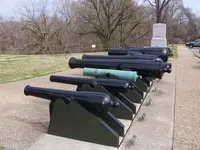I love Vicksburg!! Shane, it looks like you and Angela had a very good visit, beautiful weather too. Staying at one of the Bed & Breakfast Inns, is the best way to complete this trip. Thanks for sharing this beautiful historical landmark with everyone. With Shane's permission, I'm including a little history behind the USS Cairo.
The USS Cairo at Vicksburg
First Ship Sunk by a Naval Mine in Warfare
The Ironclad Cairo was sunk during the US Civil War by two Confederate sailors and their homemade naval mines, ushering in a new era in naval warfare
The U.S.S. Cairo was one of seven ironclad gunboats named in honor of towns along the upper Mississippi and Ohio rivers. These powerful ironclads were formidable vessels, each mounting thirteen big guns (cannon). On them rested in large part, Northern hopes to regain control of the lower Mississippi River and split the Confederacy in two. The "city class" gunboats were designed by Samuel M. Pook and built by river engineer James B. Eads. Cairo was constructed at Mound City, Illinois, and commissioned in January 1862 under the command of Lt. Commander Thomas O. Selfridge, Jr.
The ship was 175 feet long, 51 feet wide, weight was 512 tons, draft 6 feet. The ship carried 13 modern guns made up of three 4 pounder army rifle, three 64 pounder Navy smoothbore cannon, six 32 pounder Navy smoothbores, and one 30 pounder Parrott. The naval crew had 17 officers, 27 petty officers, 111 seamen, 3 landsmen, 12 firemen, and 4 "coal heavers". Powered by two steam engines with five coal fueled boilers propelling a recessed paddle wheel the ship could reach up to seven knots. The boilers operated at 140 pounds per square inch steam pressure and consumed almost a ton of coal per hour. The iron plating was mounted as part of the sloping casemate that enclosed the gun deck. The 2 1/2 inch thick charcoal plate iron was backed by a two foot thickness of white oak timbers to absorb the shock of impacting shells. It was considered a moving monster capable of retaking the river in the face of almost any land bound artillery.
The Cairo became attached to the Army's Western Gunboat Fleet. It captured Clarksville and Nashville, Tennessee, in February and two months later took a small part in the battle to capture Fort pillow. On June 6 1862, the Cairo joined eight other Union ships against an equal number of Confederate gunboats off Memphis, Tennessee in which all of the confederate vessels were sunk or grounded.
On December 12 1862, the ironclad was leading a small group of vessels clearing Confederate naval mines just north of Vicksburg near Haines Bluff and began taking shore fire from small arms along the bank. As Captain Selfridge ordered his vessel to close with the shoreline two Confederate sailors, Acting Masters Zedekiah McDaniel and Francis M. Ewing, hid behind a river bank and waited as the Cairo came into range of their mines.
The mines (referred to as torpedoes at the time) were homemade contraptions made from 5-gallon glass bottles filled with some forty pounds of black powder and attached to a wooden float anchored to the bottom of the river. Copper wires lead to a galvanic cell on shore where the confederate volunteers waited. The Cairo was rocked by two explosions in quick succession which tore gaping holes in the ship's hull. Within twelve minutes the ironclad sank into six (6) fathoms (36 feet) of water in the Yazoo River without any loss of life. Cairo became the first ship in history to be sunk by an electrically detonated torpedo.
Discovered in 1956 buried under an accumulation of river silt the Cairo was eventually raised and installed as a part of the Vicksburg Military Park in 1977 where it can now be seen by the public. Its cannon are the only actual period pieces found in the entire park, the rest being reproductions. Its steam plant is also considered the best preserved of its type in the world.
More history and pictures at this site...
http://www.civilwaralbum.com/cairo/index.htm









